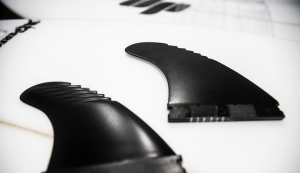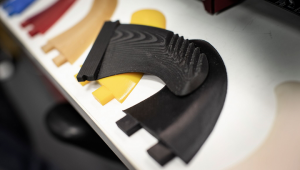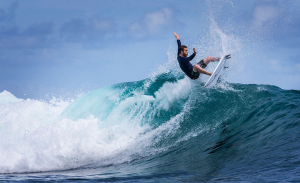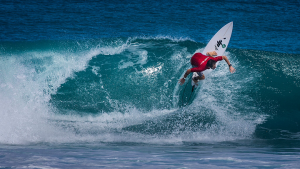 If you like 3D printing just as much as you enjoy riding those gnarly waves, you may remember when a research team from the University of Wollongong (UOW) in Australia started 3D printing surfboard fins specifically tailored to the needs of the individual surfer two years ago. This research has continued, and a multidisciplinary team of UOW students and academics from the university’s Australian National Fabrication Facility (ANFF), along with several surfers, recently took a trip to hang ten at the remote Mentawai Islands in Indonesia, and test out new shapes of surfboard fins, which were designed and 3D printed at UOW.
If you like 3D printing just as much as you enjoy riding those gnarly waves, you may remember when a research team from the University of Wollongong (UOW) in Australia started 3D printing surfboard fins specifically tailored to the needs of the individual surfer two years ago. This research has continued, and a multidisciplinary team of UOW students and academics from the university’s Australian National Fabrication Facility (ANFF), along with several surfers, recently took a trip to hang ten at the remote Mentawai Islands in Indonesia, and test out new shapes of surfboard fins, which were designed and 3D printed at UOW.
The project is part of UOW’s Global Challenges Program, with an initial goal of testing out several of these new 3D printed fin shapes and comparing them against conventional fins. But the researchers also hope to determine the possibility of developing a new niche manufacturing industry out of 3D printed surfboard fins.
“There is a lot to a simple surfboard fin, you have to consider the fin base, depth, rake (or sweep), foil, cant, toe and flex,” said Professor Marc in het Panhuis from the university’s School of Chemistry, who worked on the last 3D printed surfboard fin project. “Not to forget, the number of fins and their positioning on a surfboard.
“There is no such thing as a simple surfboard fin. The team has looked at things different materials that can make the fin stronger, lighter and its ability to flex.”
 According to Professor in het Panhuis, ocean swell and a good surfboard, fitted with the proper fins, are both equally important to surfers. While these 3D printed fins may look like commercially available ones, Professor in het Panhuis said that “the proof is in the ride.”
According to Professor in het Panhuis, ocean swell and a good surfboard, fitted with the proper fins, are both equally important to surfers. While these 3D printed fins may look like commercially available ones, Professor in het Panhuis said that “the proof is in the ride.”
Dr. Stephen Beirne with the university’s ANFF said that this is the perfect project to conduct trials on 3D printing and rapid prototyping.
“3D printing enables us to print virtually anything we can imagine and that includes surfboard fins. Our team started out creating CAD-generated fin designs on a computer, then we took those designs and used computational fluid dynamics to see how the fin was likely to perform in the water,” explained Dr. Beirne. “The last part of the process was to select the most appropriate materials to print the prototype.”
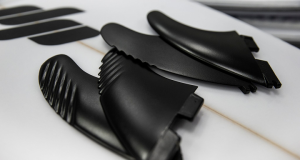 3D printing is often used today to fabricate equipment for real-life use in the sports and leisure industry, from protective gear – like soccer shin guards, helmets, and mouthguards – to apparel ranging from specialized footwear, eyewear, and racing gloves, and equipment such as improved snowboards, luge sleds, and even surfboards. By using this technology to create usable parts, the whole sports industry could see a 3D printed revolution in terms of customized products.
3D printing is often used today to fabricate equipment for real-life use in the sports and leisure industry, from protective gear – like soccer shin guards, helmets, and mouthguards – to apparel ranging from specialized footwear, eyewear, and racing gloves, and equipment such as improved snowboards, luge sleds, and even surfboards. By using this technology to create usable parts, the whole sports industry could see a 3D printed revolution in terms of customized products.
The UOW researchers took their time coming up with designs for the 3D printed fins, and after a long search to find the most consistent ocean waves in which to test the fins in real-world conditions, they chose the island chain off the western coast of Sumatra, as it provides both dependable waves and a variety of surf breaks, including the left-hand-breaking Macaronis wave the team used.
“Macaronis is a unique surfing spot because the waves always break on a reef in the same spot,” explained Professor in het Panhuis. “The waves also roll over a long distance and surfers can get a maximum of turns, which is perfect for collecting surfboard fin data.”
The surfers were tasked with catching a variety of waves, and performing as many turns as they could manage on each, with multiple different surfboard fins. Surfboard shaper Dylan Perese of DP Surfboards, who participated in the testing and data collection, also produced standardized surfboards for the project, so everyone had the same base.
Professor in het Panhuis then added embedded sensors and GPS tracking devices to the surfboards to gather performance data on the fins. He explained:
“The devices tracked everything from wave count, speed, number of turns to the amount of rail engaged during turning (to name but a few of the parameters). The surfers also filled out a fin performance rating scale immediately after they completed riding each set of fins. The information is then used to compare the different sets of fins.”
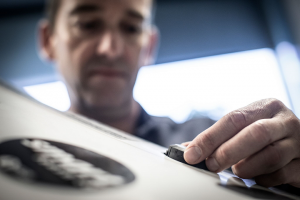 Professor Julie Steele, the Director of UOW’s Biomechanics Research Laboratory, has nearly four decades of experience running human trials, and collected the data during the trials, while also taking pains to ensure that the surfers were not biased toward any particular fin designs.
Professor Julie Steele, the Director of UOW’s Biomechanics Research Laboratory, has nearly four decades of experience running human trials, and collected the data during the trials, while also taking pains to ensure that the surfers were not biased toward any particular fin designs.
The surfers were tracked on over 450 waves, performing more than 1,700 turns, in multiple weather conditions, on three different 3D printed fin designs. The results, which should be published soon, were then compared against fins sold by two mainstream fin producers, and there was a clear winner.
“Preliminary analysis of the fin performance rating data has revealed that the surfers, on average, have rated one of the 3D printed fins as feeling the best to surf on. We were surprised that there was such a strong preference for this one fin, given the six surfers all had very different surfing styles,” said Professor Steele.
The 3D printed ‘Crinkle Cut’ fin has a series of grooves on one side, in order to increase the lift to drag ratio and propel surfers along the waves.
“The reason this fin shape works so well is because the contours improve the way the water flows past it,” Professor in het Panhuis explained. “These contours ultimately give the surfer more speed. The fins also seemed to offer plenty of drive and projection out of turns.”
So whether you’re hoping to catch the perfect wave, hit the track, or try for an Olympic medal, 3D printing could help you get to the finish line.
Discuss of this story and other 3D printing topics at 3DPrintBoard.com, or share your thoughts below.
[Images provided by UOW]Subscribe to Our Email Newsletter
Stay up-to-date on all the latest news from the 3D printing industry and receive information and offers from third party vendors.
Print Services
Upload your 3D Models and get them printed quickly and efficiently.
You May Also Like
Nikon SLM Solutions Sells SLM 500 to Primary Weapon Systems to Expand Suppressor Production
Primary Weapons Systems (PWS) is a Boise, Idaho-based manufacturer of suppressors, firearms, and related components. A subsidiary of Vigilant Gear and a sister company to aftermarket Glock slide manufacturer Lone...
3DPOD 261: Tooling and Cooling for AM with Jason Murphy, NXC MFG
Jason Murphy´s NXC MFG (Next Chapter Manufacturing) is not a generalist service; instead, the company specializes in making tooling. Using LPBF and binder jet, the company produces some of the...
HP and Firestorm Labs Form Partnership to Use Multi Jet Fusion 3D Printers in Deployable Factories
HP Inc., maker of a range of additive manufacturing (AM) solutions including the Multi Jet Fusion (MJF) ecosystem, has announced a partnership with Firestorm Labs, a developer of containerized, deployable...
3D Printing News Briefs, July 2, 2025: Copper Alloys, Defense Manufacturing, & More
We’re starting off with metals in today’s 3D Printing News Briefs, as Farsoon has unveiled a large-scale AM solution for copper alloys, and Meltio used its wire-laser metal solution to...


